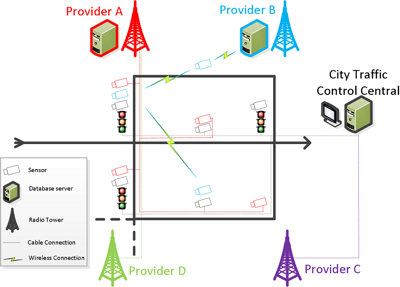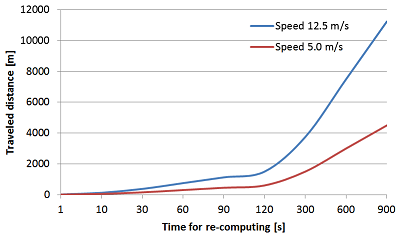Suggestion for Traffic Management and Car Navigation in Smart Cities
Autor: R. Fujdiak, J. Mišurec, P. Mlýnek <xfujdi00(at)phd.feec.vutbr.cz>, Pracoviště: Vysoké učení technické v Brně, Téma: Lokalizace polohy, Vydáno dne: 21. 03. 2014Keywords: Smart, City, Traffic, Management, Navigation, GPS, Sensor, Intelligent, Car
Introduction
The navigation systems use mostly Global Positioning System (GPS) modules [1] and offline or online maps, it depends on the devices and users [2]. The offline devices in general may work only with offline data, which cannot offer more than user could prepare before way – the shortest way, the fastest way, waypoints and maybe some additional information as places of shops, parking place and so one [3]. It is not enough for modern age of intelligent and smart devices to know only the way and positions of some services. The way may be destroyed or under construction, shops may be closed and there the offline navigation losing.
These all were the reasons to create online devices [4]. These devices may work with online maps, where should be more actual information and up-to-date maps, but also this does not offer real-time navigation system. The problem is that for this, a little bit better solution, we will need connectivity to the internet in the time of using GPS device and the real-time information of the traffic are still not provided. The maximum, which these systems provide, is some average of traffic delay for some ways [5], but this may be also included in maps of the offline devices [6].
The GPS devices with extra radio module may co-operate with private radio stations [7], where the operators give to the devices real-time information about traffic jams and many other real-time information, which the devices may use for the way computing. The radio stations using for information collecting the sensors in city and they provide this information as special services for month fee.
The problem is that the all devices and systems do not co-operate with the central city traffic control central, which involves the whole traffic situation in the city [8]. In advance, if the real-time information will start to be business, the city will have millions of sensors from the different companies, which will not co-operate together and which will not help to the system. The idea is to create a system, which will provide real-time information to the cars, which will positively involve the situation in the city traffic.
TODAY’S NAVIGATION SYSTEMS
Figure 1 describes today’s situation in the traffic navigation and management. There are many providers, city control traffic system, many sensor systems and other devices. The provider A is independent, it has own sensor network and data server, provider D is not-independent and buys information from the provider A and offers it also on the market as own service. The provider B uses own sensor network by using wireless technology. The city traffic control central has own cable network and also own sensor network and it sells information to the provider C, which sells this information selling as own service in the market.

Fig. 1: Today's system of providing real-time information
The first problem is that many devices are used for one thing, second problem is that this solution does not deal with the traffic problem. It is only some services, which offers some companies and it is a little bit higher comfort for customers of GPS Modules. The smart and intelligent traffic navigation and management system should offer solution, which must optimize the situation and also help with the situation in the city traffic. Today’s solutions give only information about the problems in the traffic as special service and do not deal with the problematic situation.
REAL-TIME TARFFIC NAVIGATION AND MANAGEMENT SYSTEM
We have a simple example of traffic situation (Figure 2), where some problems occur (Figure 3) – the accident in Road B and planned construction with big traffic jam in Road C.

Fig. 2: Example of Traffic Situation

Fig. 3: Example of Problem on the Road
The classic GPS navigations will show the shortest way and put driver in to the Road B, customers of the radio providers will probably know about some situations and will go into one of the three roads. It depends on density of their provider’s sensor network. As evident, many cars will go on the roads B and C and the problem in the traffic will grow. If we do not look at the information of traffic as service but as a possibility how to manage the traffic, the situation will change a little bit. The interest that the drivers will get real-time information how to reach their destination and evade the problems on the street should be interest mainly of the city traffic control center, which should manage the traffic in the city. If the navigation system of the car and also the city traffic control center could co-operate it should be one step closer to the intelligent and smart solution for the traffic. The control center will provide information and the drivers will evade the problems on the road. This should help there, where more and more cars going in to the traffic problem (traffic jams, construction etc.) on the road. The drivers will not anymore go to the jams and wait there and the city traffic central will have better control in the situation on the roads in cities. This solution should influence the environment in the city, time of the citizens or drivers and money on both sides. The problem is how to provide the information from the sensors to the drivers. This problematic is discussed in the following chapter.
POSSIBILITIES FOR INFORMATION PROVIDING
It is here some papers, which deal this problematic, but they trying to provide solution with many new devices and technologies, which needs to be created [9] [10] [11]. We would like to try different way, which should count with modern smart city. We will count that we have enough sensors in the city in the spots, where they are needed – mostly in big roads, where the traffic jams often occur. The city should it provide, concretely city traffic control center should do it and also this central should provide the database with all necessarily information about planned construction on the roads and closed roads. Now we need to provide the information to the drivers. The basic possibilities for the information providing may be:
- Wireless AP in specific spots providing the information, when driver is in distance.
- Radio/GPRS Tower providing through operators the real-time information of the system.
These solutions have many troubles. First, AP Wireless providing information only in specific spots, then it is also not exactly real-time solution if the network does not have enough density, but with the density is also connected the money prize of the whole system [12]. The second solution count free vision to the transmitters or some extra operator center, radio channel and so on [13]. These solutions have big finances requirements and they are not appropriate for our situation.
The solution may be quite simple. The communication between drivers and database can be only simplex, where they will get only information for their devices. Most of the big cities provide 2G/3G technology networks and in the future 4G/5G networks are planned. These networks should have space for providing simple services for the city and help with the solution [14]. Another task, which must deal with, is GPS Navigation system and this is also a topic of the next chapter.
GPS NAVIGATION SYSTEM
The navigation system must offer enough power for computing and re-computing the way. The average speed in the city is from 5 m/s (New York) to 12.5m/s (Tulsa). Figure 4 shows dependency of the time and travelled distance.

Fig. 4: How the computing depend on the travelled distance
It is evident that with growing time for the re-computing some information of the traffic should be irrelevant for us and should not start new re-computing process. This may be provided by information in good format, where every road will have growing value, which will depend on the situation. This value, for example h, will influence choosing a way and also re-computing, which will have some borders. These borders will define when it is necessary to start re-computing process. The way finding must be based on the modern fast algorithms, which will provide enough speed for computing, but with no big requirements for power resources.
Conclusion
The system described in this article is a basic for the future research, which should help with optimizing the traffic situation in the future intelligent cities. The suggestion is based on the planned future situation, which should provide required resources as for example good sensor networks.
The main part of the suggestion is that the cars will co-operate with city traffic central, which it will give to the GPS modules necessary information, from this both sides should profit. The drivers should save time and money and the city should have less traffic jams – less nature environment damage and better import and export.
The next task should be simulation process, which will show effectiveness of the system and another attributes. This simulation may be done in NS3 software or also in own system which will be created for concrete situation with concrete requirements.
The bad traffic situation takes big part of their time from the community, also money and influences in bad way the nature environment. The solution provided in this article does not count with creating totally new system with many new devices, but it tries to connect the existing and planned systems for the traffic optimization.
ACKNOWLEDGE: This work was supported in part by project TACR 02020856
References
[1] Trimble. “GPS. The First Global Navigation Satellite System.” http://www.saveourgps.org, 2007. [Online]. Available (Accessed: Mar. 17. 2014):
http://www.saveourgps.org/pdf/GPS-The-First-Global-Satellite-Navigation-System-by-Trimble.pdf
[2] National Geographic. “Basic Map & GPS Skills” http://maps.nationalgeographic.com. [Online]. Available (Accessed: Mar. 17. 2014):
http://maps.nationalgeographic.com/downloads/Map_Skills_Booklet.pdf
[3] GaiaGPS. “Gaia GPS User Manual” http://gaiagps.appspot.com. [Online]. Available (Accessed: Mar. 17. 2014):
http://gaiagps.appspot.com/static/manual.pdf
[4] D. Adomatis. “Make Your Own GPS Maps” http://www.travelbygps.com. [Online]. Available (Accessed: Mar. 17. 2014):
http://www.travelbygps.com/articles/Make%20your%20own%20GPS%20Maps.pdf
[5] F. Cevallos, Q. Yuan, X. Wang, J. Skinner and A. Gan. “Feasibility Study on the Use of Personal GPS Devices in Paratransit.” Report. OMB No. 0704-0188. May 2009.
[6] MotionX®. “User Manual (Revision 16.0).” http://drive.motionx.com. August 2013. [Online]. Available (Accessed: Mar. 17. 2014):
http://drive.motionx.com/downloads/MotionX-GPS-Drive-Manual.pdf
[7] R. P. Schafer. “Traffic Information by Means of Real-time Floating Car Data.” http://www.ertico.com. September. 2013. [Online]. Available (Accessed: Mar. 17. 2014):
http://www.ertico.com/assets/download/peace/septemb_dlr.pdf
[8] Urban ITS Expert Group. “Guidelines for ITS deployment in Urban Areas.” http://ec.europa.eu. Jan. 2013. [Online]. Available (Accessed: Mar. 17. 2014): http://ec.europa.eu/transport/themes/its/road/action_plan/doc/2013-urban-its-expert_group-guidelines-on-traffic-management.pdf
[9] S. Tao, V. Manolopoulos, S. Rodriguez and A. Rusu. „Real-Time Urban Traffic State Estimation with A-GPS Mobile Phones as Probes“ Journal of Transportation Technologies, vol. 2, pp. 22-31, 2012.
[10] T. Zhong, B. Xu and O. Wolfson. “Disseminating Real-Time Traffic Information in Vehicular Ad-Hoc Networks.” publication and plenary presentation, Proceedings of the IEEE Intelligent Vehicles Symposium, Eindhoven, The Netherlands, June, 2008, pp. 1056-1061.
[11] TomTom. “How TomTom’s HD TrafficTM and IQ RoutesTM data provides the very best routing.” HDT White Paper. 2013.
[12] ProCurve Networking. “Troubleshooting WLAN Connectivity.” Technical White Paper. [Online], Available (Accessed: Mar. 17):
http://www.hp.com/rnd/pdfs/Troubleshooting_WLAN_Connectivity.pdf
[13] MorganDoyle Limited. “GPRS Tutorial.” [Online]. Available (Accessed: Mar. 17. 2014):
http://www.item.ntnu.no/fag/tm8100/Pensumstoff2004/GPRS_Tutorial.pdf
[14] M. R. Bhalla and A. V. Bhalla. “Generations of Mobile Wireless Technology a Survey.” International Journal of Computer Applications, vol. 5 no. 4, pp. 26 – 32, August 2010.